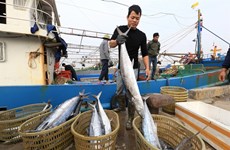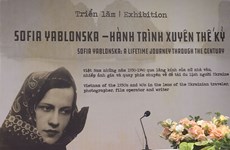Peace at the end of the road
Tran Thi Tuyet Nga first arrived in Cu Chi in 1961 when the area was peaceful
and plentiful. When she went back 10 years later, Cu Chi was a desolate
battlefield during the American War, where nothing could survive above ground.
Nga lived in a tunnel, fought and witnessed thousands of comrades sacrifice
their lives.
Tran Thi Tuyet Nga first arrived in Cu Chi in 1961 when the area was peaceful
and plentiful. When she went back 10 years later, Cu Chi was a desolate
battlefield during the American War, where nothing could survive above ground.
Nga lived in a tunnel, fought and witnessed thousands of comrades sacrifice
their lives.
Her memories of those times inspired her. She had a dream to build something wonderful there and in 1991 the first bricks were transported to Bo Cap (Scorpion) pier, Phu Binh hamlet, An Phu commune, Cu Chi district.
It has taken 18 years of hard work, determination and sacrifice and nearly 100 billion VND (around 7 million USD) for Nga and her partners to convert the swampy, crater-filled battleground into the attractive "A Glance of Viet Nam" tourism park.
Covering 22.5ha, the park contains 53 houses, 8km of road and 2.3km of irrigation canal. The designers had to use 700,000cu.m of fill and 4,000 cajuput piles to reclaim it from the swamp. Nga’s vision was to make a place that celebrated everything that Viet Nam had to offer.
The temple for country is the most exciting place. The mortar used to build the altar contains soil and water taken from famous landmarks of Viet Nam, including the country’s most northern part of Lung Cu Mountain in Ha Giang; Dien Bien Phu where the army was victorious against the French; Co Loa ancient citadel – the legendary capital of ancient Viet Nam; and Truong Son National Cemetery, where 10,000 War martyrs are laid to rest.
"The temple for country is the place where we pray for a strong and wealthy Viet Nam," Nga, chairwoman of the park, said.
Outside the temple, three ironwood piles from the Bach Dang River in the northern port city of Hai Phong are on display.
They were used by General Ngo Quyen to defeat the Chinese navy’s invasion in 938.
An exhibition has displays of artifacts from the Dinh, Le, Ly and Tran dynasties, and various wars over the past several thousand years.
There is a 55m long map of Viet Nam with surrounds designed like a Vietnamese bronze drum.
One of the park’s great achievements is the selection of traditional houses from different parts of the country – a typical northern house, a traditional southern residence, a mud house from the central province of Binh Dinh, a ruong wooden dwelling from Hue, a rong long house from the central highlands, and a long house of the E De ethnic people.
All houses here were made of local materials using workers from the area.
"We want everything to be as real as possible. I hope the collection will be meaningful for visitors," Nga said.
The park is also set up like a craft village featuring craftspeople doing rattan and silk weaving, wood carving, aquaculture rice cultivation, ornamental planting, embroidery and conical hat making. The craftspeople have been brought from their villages and are happy to talk about how they do it. "I’ve lived and worked here for eight years. My job is much more stable than if I worked outside," wood craftsman Nguyen Thanh Trung said.
The park also has a collection of 500 different types of trees, including 50 kinds of bamboo.
"Viet Nam is the home of bamboo and we aim to make more products from it," Nga added.
Restaurants serve food from the three regions.
Recently the park has included music and dance performances by young Thai ethnic women from the northern province of Yen Bai.
A traditional playground lets children see the games their ancestors played when they were kids.
"The park is good for families to discover their culture and history," Nguyen Van My, director of Lua Viet Tour company, said.
"We would like to do something for the land. It is a way for us to promote our culture in a unique way," Nga said.
The tourism park is 60km from downtown HCM City./.
Her memories of those times inspired her. She had a dream to build something wonderful there and in 1991 the first bricks were transported to Bo Cap (Scorpion) pier, Phu Binh hamlet, An Phu commune, Cu Chi district.
It has taken 18 years of hard work, determination and sacrifice and nearly 100 billion VND (around 7 million USD) for Nga and her partners to convert the swampy, crater-filled battleground into the attractive "A Glance of Viet Nam" tourism park.
Covering 22.5ha, the park contains 53 houses, 8km of road and 2.3km of irrigation canal. The designers had to use 700,000cu.m of fill and 4,000 cajuput piles to reclaim it from the swamp. Nga’s vision was to make a place that celebrated everything that Viet Nam had to offer.
The temple for country is the most exciting place. The mortar used to build the altar contains soil and water taken from famous landmarks of Viet Nam, including the country’s most northern part of Lung Cu Mountain in Ha Giang; Dien Bien Phu where the army was victorious against the French; Co Loa ancient citadel – the legendary capital of ancient Viet Nam; and Truong Son National Cemetery, where 10,000 War martyrs are laid to rest.
"The temple for country is the place where we pray for a strong and wealthy Viet Nam," Nga, chairwoman of the park, said.
Outside the temple, three ironwood piles from the Bach Dang River in the northern port city of Hai Phong are on display.
They were used by General Ngo Quyen to defeat the Chinese navy’s invasion in 938.
An exhibition has displays of artifacts from the Dinh, Le, Ly and Tran dynasties, and various wars over the past several thousand years.
There is a 55m long map of Viet Nam with surrounds designed like a Vietnamese bronze drum.
One of the park’s great achievements is the selection of traditional houses from different parts of the country – a typical northern house, a traditional southern residence, a mud house from the central province of Binh Dinh, a ruong wooden dwelling from Hue, a rong long house from the central highlands, and a long house of the E De ethnic people.
All houses here were made of local materials using workers from the area.
"We want everything to be as real as possible. I hope the collection will be meaningful for visitors," Nga said.
The park is also set up like a craft village featuring craftspeople doing rattan and silk weaving, wood carving, aquaculture rice cultivation, ornamental planting, embroidery and conical hat making. The craftspeople have been brought from their villages and are happy to talk about how they do it. "I’ve lived and worked here for eight years. My job is much more stable than if I worked outside," wood craftsman Nguyen Thanh Trung said.
The park also has a collection of 500 different types of trees, including 50 kinds of bamboo.
"Viet Nam is the home of bamboo and we aim to make more products from it," Nga added.
Restaurants serve food from the three regions.
Recently the park has included music and dance performances by young Thai ethnic women from the northern province of Yen Bai.
A traditional playground lets children see the games their ancestors played when they were kids.
"The park is good for families to discover their culture and history," Nguyen Van My, director of Lua Viet Tour company, said.
"We would like to do something for the land. It is a way for us to promote our culture in a unique way," Nga said.
The tourism park is 60km from downtown HCM City./.












